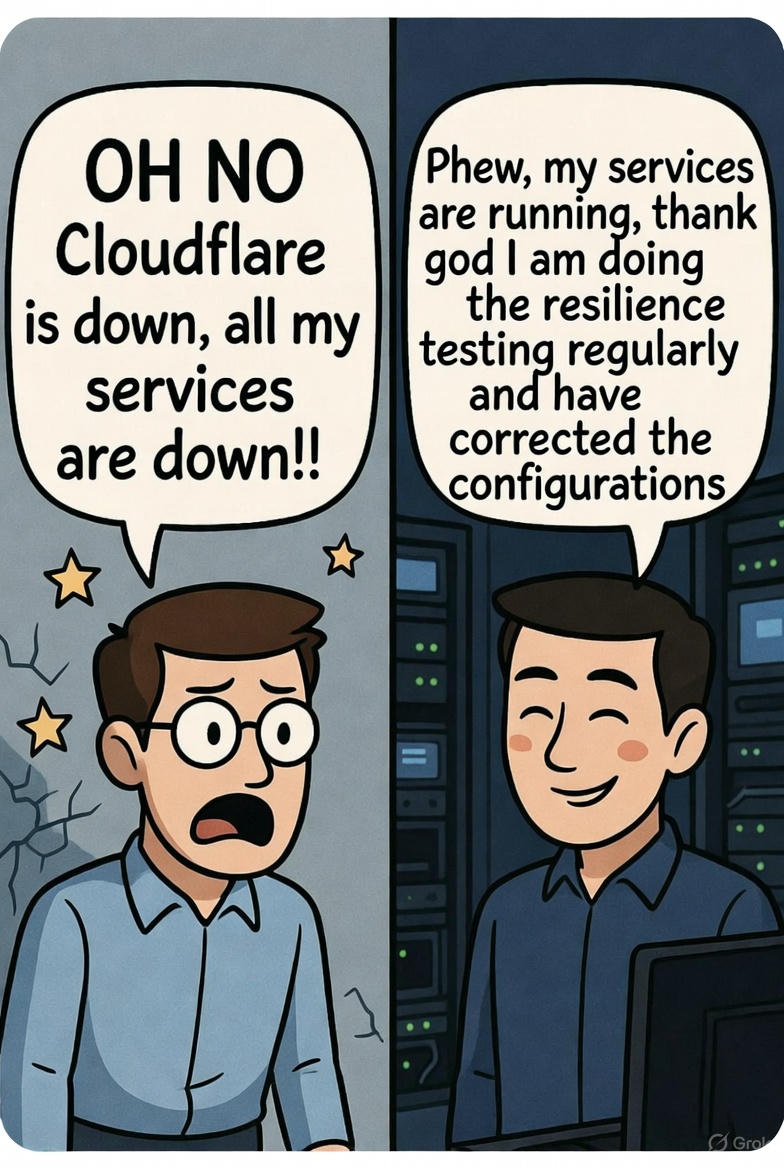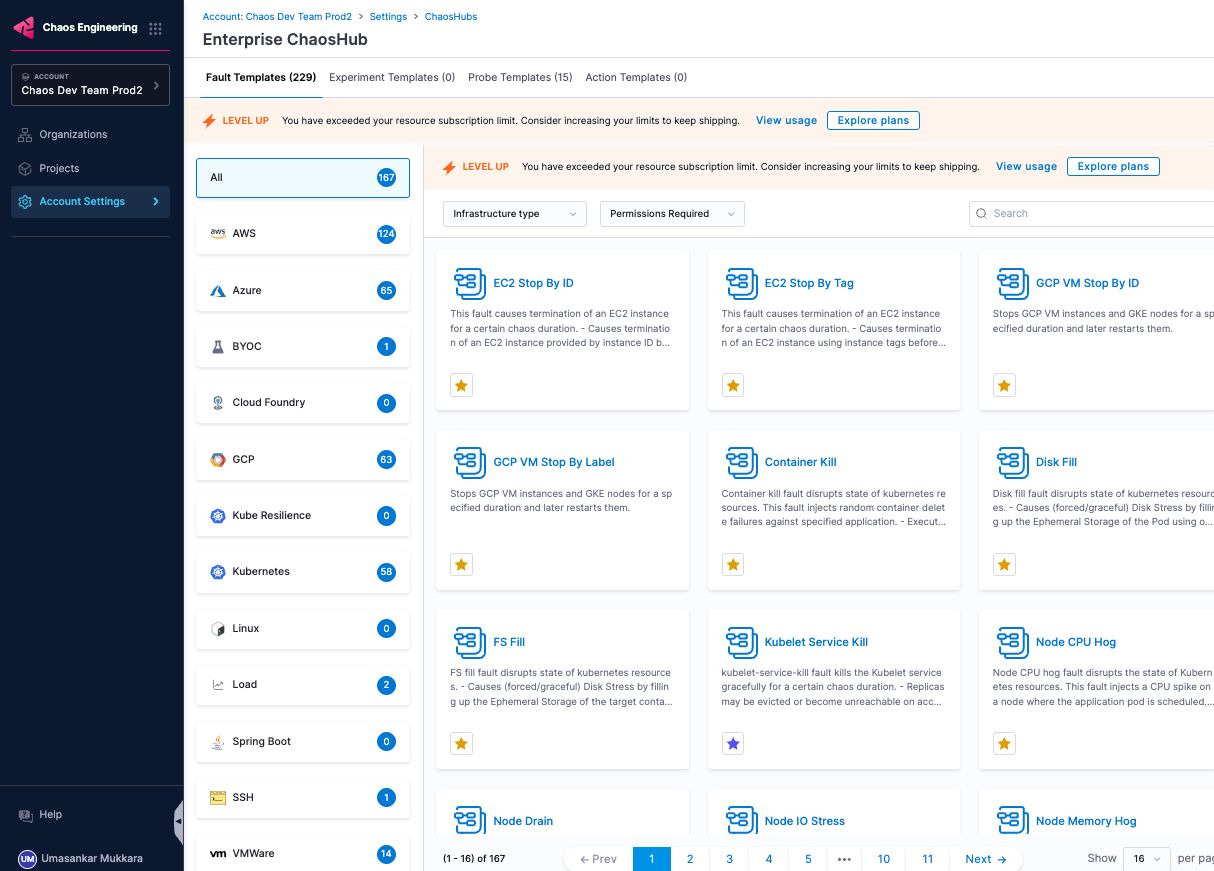
Cloudflare-like outages can cost your business a significant amount of money. This week’s Cloudflare global outage is a wake-up call for business resilience. You can stay resilient against such outages by regularly performing resilience testing and updating your application or infrastructure configurations.
In the fast-paced digital world, a single point of failure can ripple across the globe, halting operations and frustrating millions. On November 18, 2025, that's exactly what happened when Cloudflare—a backbone for internet infrastructure—experienced a major outage. Sites like X (formerly Twitter), ChatGPT, and countless businesses relying on Cloudflare's CDN, DNS, and security services ground to a halt, serving 5xx errors and leaving users staring at blank screens. If your business depends on cloud services, this event is a stark reminder: resilience isn't optional; it's essential.
As sponsors of the Chaos Engineering tool LitmusChaos and as providers of resilience testing solutions from Harness, we've seen firsthand how proactive testing can turn potential disasters into minor blips. In this post, we'll break down what went wrong, the ripple effects on businesses, proven strategies to bounce back stronger, and why tools like ours are game-changers. Let's dive in.
What Happened During The Cloudflare Outage?
The outage kicked off around 11:20 UTC on November 18, with a surge in 5xx errors hitting a "huge portion of the internet." Cloudflare's internal systems degraded due to a configuration or database schema mismatch during a software rollout, triggering panic in shared mutable state initialization. This wasn't a cyberattack but a classic case of human error amplified by scale—think of it as deploying a patch that accidentally locks the front door while everyone's inside.
Affected services spanned the board: the Cloudflare Dashboard saw intermittent login failures, Access and WARP clients reported elevated error rates (with WARP temporarily disabled in London during fixes), and application services like DNS resolution and content delivery faltered globally. High-profile casualties included X, where thousands of users couldn't load feeds, and OpenAI's ChatGPT, which became unreachable for many. The disruption lasted about eight hours, with full resolution by 19:28 UTC after deploying a rollback and monitoring fixes.
Cloudflare's transparency in their post-mortem is commendable, but the event underscores how even giants aren't immune. For businesses, it was a costly lesson in third party dependency and not having enough confidence on the service being resilient.
How Can Your Business Be affected?
You may be depending on service providers like Cloudflare for handling DNS, DDoS protection, and edge caching. When they hiccup, the fallout is immediate and far-reaching:
- Revenue Loss: Online retailers like Shopify stores or Amazon affiliates saw carts abandoned mid-checkout. A single hour of downtime can cost mid-sized e-commerce businesses $10,000–$100,000 in lost sales, per industry benchmarks.
- User Experience Degradation: Streaming services buffered endlessly, social platforms froze, and collaboration tools like Slack integrations failed, eroding trust. Frustrated users churn—studies show a 7% drop in conversions per second of delay.
- Operational Chaos: DevOps teams scrambled with alerts firing, while customer support lines lit up. For global firms, the staggered impact across time zones meant 24/7 firefighting.
- Long-Term Hits: SEO rankings dip from crawl errors, and compliance headaches arise if SLAs are breached. In regulated sectors like finance or healthcare, this could trigger audits or fines.
This outage hit during peak hours for Europe and the Americas, amplifying the pain for businesses already stretched thin post-pandemic. It's a reminder: your uptime is only as strong as your weakest link.
Recommended Resilience Architecture For Your Business Services
Staying resilient doesn't require reinventing the wheel—just smart layering. Here are five battle-tested practices, each with a quick how-to:
1. Multi-Provider Redundancy: Don't put all eggs in one basket. Route traffic through alternatives like Akamai or Fastly for failover. Tip: Use anycast DNS to auto-switch providers in under 60 seconds.
2. Aggressive Caching and Edge Computing: Pre-load static assets at the edge to survive backend blips. Tip: Implement immutable caching with TTLs of 24+ hours for non-volatile content.
3. Robust Monitoring and Alerting: Tools like Datadog, Dynatrace or Prometheus can detect anomalies early. Tip: Set up synthetic monitors that simulate user journeys, alerting on >1% error rates.
4. Graceful Degradation and Offline Modes: Design apps to work partially offline—queue actions for retry. Tip: Use service workers in PWAs to cache critical paths.
These aren't silver bullets, but combined, they can cut recovery time from hours to minutes.
Cloudflare also must be doing everything that is possible to stay resilient. However, small failures either in the infrastructure, or applications or third party dependencies are inevitable. Your services must continue to stay resilient against potential failures. How? The answer lies in verifying as frequently as possible that your business services are resilient and if not, keep making corrections.

Why Is Regular Resilience Testing Non-Negotiable?
Outages like Cloudflare's expose the "unknown unknowns"—flaws that only surface under stress. Regular testing flips the script: instead of reactive firefighting, you're proactive architects.
Even though you have architected and implemented the good practices for resilience, there are lot of variables which can change your resiliency assumptions.
- Code changes are deployed and software is updated on your application or underlying infrastructure clusters.
- Configurations/behavior of the underlying infrastructure is updated. E.g: One of the services is moved from one VM to another VM with a lower configuration.
- New dependent services are introduced.
Unless you have enough resilience testing coverage with every change, you always will have unknown unknowns. With known unknowns, you at least have a tested mechanism on how to respond and recovery quickly.
Harness Chaos Engineering Strengthens Your Resilience Posture
- Network Latency and Packet Loss: Mimic DNS resolution delays or edge routing fails. Probe how your app handles 500ms+ lags—perfect for testing failover to secondary CDNs.
- Service Outage Simulation: "Kill" external dependencies like API calls to Cloudflare services. Use resilience probes to verify if your system auto-retries or degrades gracefully.
- Resource Contention Faults: Stress CPU/memory to echo overload from traffic spikes. ChaosGuard ensures experiments stay within guardrails, preventing cascade failures.
- Pod/Node Terminations (for K8s Users): Randomly evict resources to test scaling. Integrate with GitOps for automated rollbacks if thresholds breach.
- File or Disk size increases: Increase the files size, fill the underly disks or fill the database tables with fillers. Use resilience probes to verify if other services are functional. In the case of the Cloudflare outage, the root cause on their side appears to be increased file size or database changes, which might have been averted with regular resilience testing practice.
These aren't one-offs; run them in steady-state probes for baseline metrics, then blast radius tests for full-system validation. With AI-driven insights, Harness flags weak spots pre-outage—like over-reliance on a single provider—and suggests fixes. Early adopters report 30% uptime gains and halved incident severity.
Harness Chaos Engineering provides hundreds of ready to use fault templates to create required faulty scenarios and integrations with your APM systems to verify the resilience of your business services. The created chaos experiments are easy to add to either your deployment piplelines like Harness CD, GitLab, GitHub actions or to your GameDays.

Ready To Outage-Proof Your Business?
The Cloudflare outage was a global gut-check, but it's also an opportunity. By auditing dependencies today and layering in resilience practices—capped with tools like Harness—you'll sleep better knowing your services can weather the storm.
What's your first step? Audit your Cloudflare integrations or spin up a quick chaos experiment. Head to our Chaos Engineering page to learn more or sign up for our free tier with all the features that only limits the number of chaos experiments you can run in a month.
If you wish to learn more about resilience testing practices using Harness, this article will help.
Are you ready to outage-proof your business? Let's build a more unbreakable internet together, one test at a time.

.jpeg)